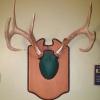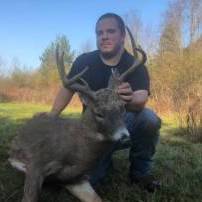
Hunters in New York State harvested more than 228,350 deer and 1,250 bears during the 2011 hunting seasons, New York State Department of Environmental Conservation (DEC) Commissioner Joe Martens announced today. The deer take nearly matched the 2010 deer take while a new record was set for the bear harvest in southern New York.
“Deer and bear hunting are long-standing traditions in New York, providing a valuable source of food and a means of shared recreation for many families,” Commissioner Martens said. “Throughout the state, hunters play a crucial role by helping to maintain healthy and ecologically sound deer and bear populations.”
Deer Harvest
The 2011 deer take varied less than one percent from the 2010 take statewide. In 2011, hunters took slightly more than 118,350 antlerless deer (adult females and fawns) and just over 110,000 adult male deer (bucks). In the northern zone, the buck take (about 15,900) was essentially unchanged from 2010, though the antlerless harvest (about 10,900) was down about 13 percent from last year. In the southern zone, excluding Long Island, the adult buck take (about 93,100) increased nearly four percent over last year while the antlerless harvest (about 105,400) decreased by three percent.
2011 marked the first year that crossbows were allowed as a legal hunting implement for deer. However, legislation limited crossbow use to the regular firearms seasons and subsequent muzzleloader seasons for deer. Relatively few hunters took crossbows afield and the estimated take by crossbows was only 491 deer statewide, less than 0.25 percent of the total deer harvest.
Throughout the state, hunters took a slightly higher proportion of 2.5-year-old and older bucks than in previous years, continuing a trend that has developed over the past two decades. Throughout most of New York, hunters can take a buck of any age, but an increasing number of hunters are voluntarily choosing to take older bucks with larger antlers. In 2011, 46 percent of harvested bucks were 2.5-years-old or older, compared to only 33 percent in 2000 and 28 percent in the early 1990s.
Western New York and the Finger Lakes Region perennially lead the state in total deer-harvest densities, and deer take in 2011 remained true to form. The top five counties for 2011 were Yates (16.4 total deer per square mile), Wyoming 13.8 , Genesee 10.8, Ontario 10.5, and Livingston 10.0.
It’s important to note that the total deer harvest is strongly impacted by the number of Deer Management Permits (DMPs) available in a given area, which govern the harvest of antlerless deer and are used to manage the deer population in a given area.
A more accurate picture of relative deer abundance is revealed by the number of bucks harvested per square mile. The five counties with the most bucks harvested per square mile were: Yates (5.6), Wyoming (5.4), Orange (4.1), Ontario (4.1), and Allegany (4.0). The deer populations in four of the counties listed above (all except Allegany County) are higher than the deer population objectives set for those counties. DEC will continue its efforts to reduce the deer population to achieve the desired density levels wherever necessary.
In 2011, DEC adopted a white-tailed deer management plan (see: www.dec.ny.gov/animals/7211.html#DeerPlan). The plan will guide DEC deer management and deer hunting decisions for the next five years. In the upcoming weeks, DEC will propose several regulation changes that were identified in the deer management plan. Hunters and the public will have the opportunity to comment on these changes when a formal proposal is made. Some of the proposed revisions include:
· change the start date of the southern zone bow season to October 1;
· establish a youth hunt for deer;
· allow DMPs to be used during the northern zone bow and muzzleloader seasons;
· establish mandatory antler restrictions in seven additional Wildlife Management Units in the Catskills;
· establish a late bowhunting season in portions of the northern zone; and
· establish Deer Management Focus Areas to expand the use of traditional hunting in areas with overabundant deer.
Bear Harvest
Outside of the Adirondack region the 2011 bear harvest set new records, substantially exceeding previous record takes in central and western New York. In contrast, bear take in the Adirondack region dropped to a level not seen since 1998.
Hunters in southeastern New York harvested 630 bears in 2011, besting the previous record of 520 set in 2008. This was due in part to a new rule that expanded bear hunting in eastern New York State to include all or portions of seven new counties in eastern New York from Rockland and Westchester north to Washington beginning in 2011. Hunters took 50 bears from this new area, including 18 bears taken in Washington County, 11 in Rensselaer County, 10 in Columbia County, seven in Dutchess County, two in Putnam County and two in Rockland County. Yet even without these additional bears, take in the rest of the southeastern region exceeded previous record levels, reflecting a 25-year trend of generally increasing bear harvests in this region.
In central and western New York, the 2011 bear take of 353 greatly surpassed the previous record of 193 bears set in 2008. This was due in large part to a regulation change that moved the regular bear season opening day up one week to coincide with the start of the regular deer season. This change was implemented to reduce bear population growth and range expansion. Yet, as with bear take in the southeastern region, it is likely that even without these additional seven days of the regular season in the central-western region, bear take during the traditional season would have matched or exceeded the 2008 record, reflecting a 15-year trend of generally increasing bear harvests in this region.
In the Adirondacks, bear take was below the five-year average during each of the bear seasons and the overall bear take was down about 47 percent from 2010.
Bear harvest rates in the Adirondacks typically drop in the early season during years of abundant soft mast (cherries, raspberries and apples), while the take will increase during the regular season in years with abundant beech nuts.
This past season provided abundant soft mast, particularly raspberries and blackberries in September and October, and bear take during the early season was only 70 bears, about 70 percent below the five-year average. Beech nut abundance was mixed throughout the Adirondacks and the regular season bear take was approximately 15 percent below the five-year average. Additionally, much of the muzzleloading and regular season in the Adirondacks had above average temperatures and snow cover was inconsistent and relatively scarce making bear hunting all the more challenging.
Deer and bear harvest data are gathered from two main sources: harvest reports required by all successful hunters and DEC’s examination of harvested deer and bear at check stations and meat processors. Statewide harvest estimates are made by cross-referencing these two data sources. For more information about the 2011 deer and bear harvests, see DEC’s website at: www.dec.ny.gov/outdoor/42232.html.
See attached PDF for breakdown of the harvests.










Recommended Comments
There are no comments to display.
Join the conversation
You can post now and register later. If you have an account, sign in now to post with your account.